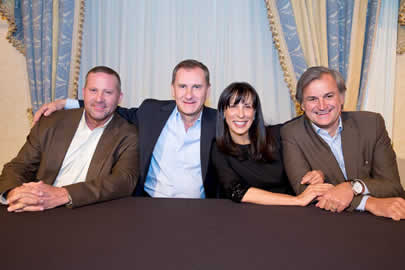
2014-04-12 23:57:54
Coty's Leadership Team Shares Its Strategies with CEW Members
2014-04-12 23:57:54
Coty celebrates its 110th anniversary this year, with a new leadership team that’s more progressive and freer thinking than ever. When an Avon buyout didn’t work out, the beauty company took a different path with an IPO last year and, in the end, reached a mutually beneficial agreement for distribution with Avon—a win-win for both parties.
When the world’s largest fragrance company saw the need for category diversification, it accelerated its skincare and nail holdings, as well as bulked up its portfolio with a few accessions. And when consumers showed a growing interest in color, Coty satisfied their needs with launches such as Calvin Klein and Marc Jacobs cosmetics.
How does Coty management work to retain its fluidity and capitalize on its innovative approach to the marketplace?
That’s what a sold-out crowd of hundreds of beauty executives aimed to learn more about as they packed Manhattan’s Harmonie Club on March 26for CEW’s Newsmaker Forum event: “Coty Prestige: Accelerating Growth.”
Panelists included Steve Mormoris, senior VP of global marketing,American Fragrances; Jean Mortier, president; Jill Scalamandre, SVP,Philosophy Brand and Coty Prestige Skincare; Marc Rey, president, U.S. and regional VP, North America. Pete Born, WWD's executive editor of beauty, served as the moderator of the lively discussion.
Most important for Coty, said Mortier, is to “try and stay entrepreneurial. “We’re a clean and lean corporation.” He said that while they have changed the organization, the framework is still the same: “We have freedom to create.”
When Born asked the team how they keep their edge now that they’re a public company, Mormoris emphasized the company’s “culture of creativity, taking risks and being able to act on instincts—continuing to do what they do best: creating brands that people love.” And doing the market research to find out why.
Scalamandre agreed with Mormoris, saying that Coty is “a company that allows you to use creativity first. Research comes second—unlike at any other company.”
Rey underlined Coty’s rapid pace. “Things happen very quickly. We move fast.”
Defining Innovation
When Born asked Mortier how he defines innovation, the president reverted back to the ingenuity of founder Francois Coty, more than a century ago. “We try to find new ways to go to the customer—now, with outlets such as QVC.”
“It’s not easy,” said Mormoris. "We have to first find a great olfactory structure and a great package design, which is a critical part of creating the mood—it needs to be fun and whimsical.”
|
|
He said that Coty has “recreated packaging,” adding that “craftsmanship from fragrance to package to advertising builds consumer loyalty.” A good example. he said, is Daisy Marc Jacobs.
Scalamandre offered an example of finding new ways to communicate with consumers, such as with the untraditional social media marketing they pursued with Philosophy's Loveswept, “in which the consumers actually ended up doing the marketing through posting little love stories, etc.”
Power Brands
When Born asked the team how it defines power brands, Mortier said Coty’s strategy in this area centers around its three greatest performers: CK, Marc Jacobs andChloe. All, he said, have gained global awareness and are “the bones of the company.”
Once established, the challenge comes in “keeping things fresh,” according to Mormoris. He says you’re always on a quest for newer younger consumers, flankers, line extensions, keeping the products alive through advertising, etc.
In regard to engaging consumers through social media, Mormoris said it’s a must for reaching a younger audience. “They can’t smell the fragrance online, but you can create a story online.”
When asked about the continuing popularity of celebrity brands, in which Coty led the phenomenon, the team acknowledged that many other manufacturers now do these types of fragrances also. Going forward--and looking at the success it has realized with its three pillar brands mentioned above--Coty plans to focus more on designer brands.
Scalamandre spoke about Coty’s diversification into skincare. She said that consumers no longer see Coty as strictly a fragrance company, as skincare is now 15% of the corporate business. In regard to Philosophy, she said it has always been “a multichannel brand with a lot of emotional benefits,” adding, “Sure, Philosophy needs some tweaking, but everything does.”
Looking Ahead
Promising additional growth also lies with one of Coty’s older portfolio members. When asked about Coty’s Lancaster skincare brand, Scalamandre said it’s still a leader in Europe and an expanding brand in Asia. In fact, she told the crowd, “Lancaster’s suncare technology can be applied to skincare—and could be the brand that bridges the two.”
Mormoris conceded that the flattening of the fragrance market, due to fragmentation in general, has put a renewed focus on skincare. He said one way Coty has gotten creative with approaches was by putting “fragrances into a can” in body sprays and selling them in supermarkets, such as with Playboy.
Scalamandre thinks innovation as far as growing the skin care market will come from technology that makes products more effective and absorb better. She said she has seen “a lot of interesting new textures being developed in Asia.”
One of the most noteworthy trends, the group said, is in China, with its focus on color. This led to the success of CK Color, in which Coty then used cosmetics as a driver for the CK fragrance.
Born’s final question: “What will a successful product look like?”
Scalamandre replied, “When we have one million people talking about it.”
Critical along with increase market share though, the group agreed their work must be fun!
LinkedIn





